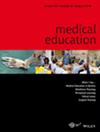Should medical teachers spend more time modelling or coaching students? A dual eye-tracking and randomised controlled study on peer instruction in sonography
Abstract
Background
When first introducing medical procedures, instructors must decide how much of their limited time must be allocated between modelling (demonstrate and explain) and coaching (scaffold and support) students. Given the time constraints in clinical routine, it is currently unknown which relative proportion of modelling versus coaching is more efficient for procedural learning.
Methods
We randomly assigned 73 students without prior knowledge to either an extended modelling (EM) or an extended coaching (EC) group for an emergency sonography training. In the EM group, medical teachers demonstrated a routine examination explaining their thought process, while also providing some coaching. In the EC group, students trained more independently with consistent teacher support, with less emphasis on modelling. We used dual mobile eye-tracking and voice recording to objectify the teacher–student interactions and applied a comprehensive assessment to understand which learning domains improved under which condition.
Results
On post-tests, the EC group outperformed the EM group by 12% in interpreting dynamic sonographic imagery (p = 0.014). They completed the ultrasound examinations 7% faster (p = 0.050). There was no statistical difference between the two groups in interpreting static sonographic imagery (p = 0.322) nor in practical scores (p = 0.062). Contrary to expectations, there were no differences between the groups in terms of eye movement metrics that explained the performance effects. However, two behavioural variables were positively related with learning outcomes across both groups: the percentage of joint visual attention between teacher and student (β = 0.316, p < 0.001) and the number of words spoken during the training (β = 0.175, p = 0.004).
Conclusion
This study provides empirical evidence that EC may be particularly effective when introducing new procedural medical skills. In learning complex procedures, direct sensorimotor experience with guided support appears more advantageous than extended observation. These findings suggest that medical educators should give students more opportunities for supervised hands-on practice rather than relying primarily on demonstration-based teaching.





 求助内容:
求助内容: 应助结果提醒方式:
应助结果提醒方式:


